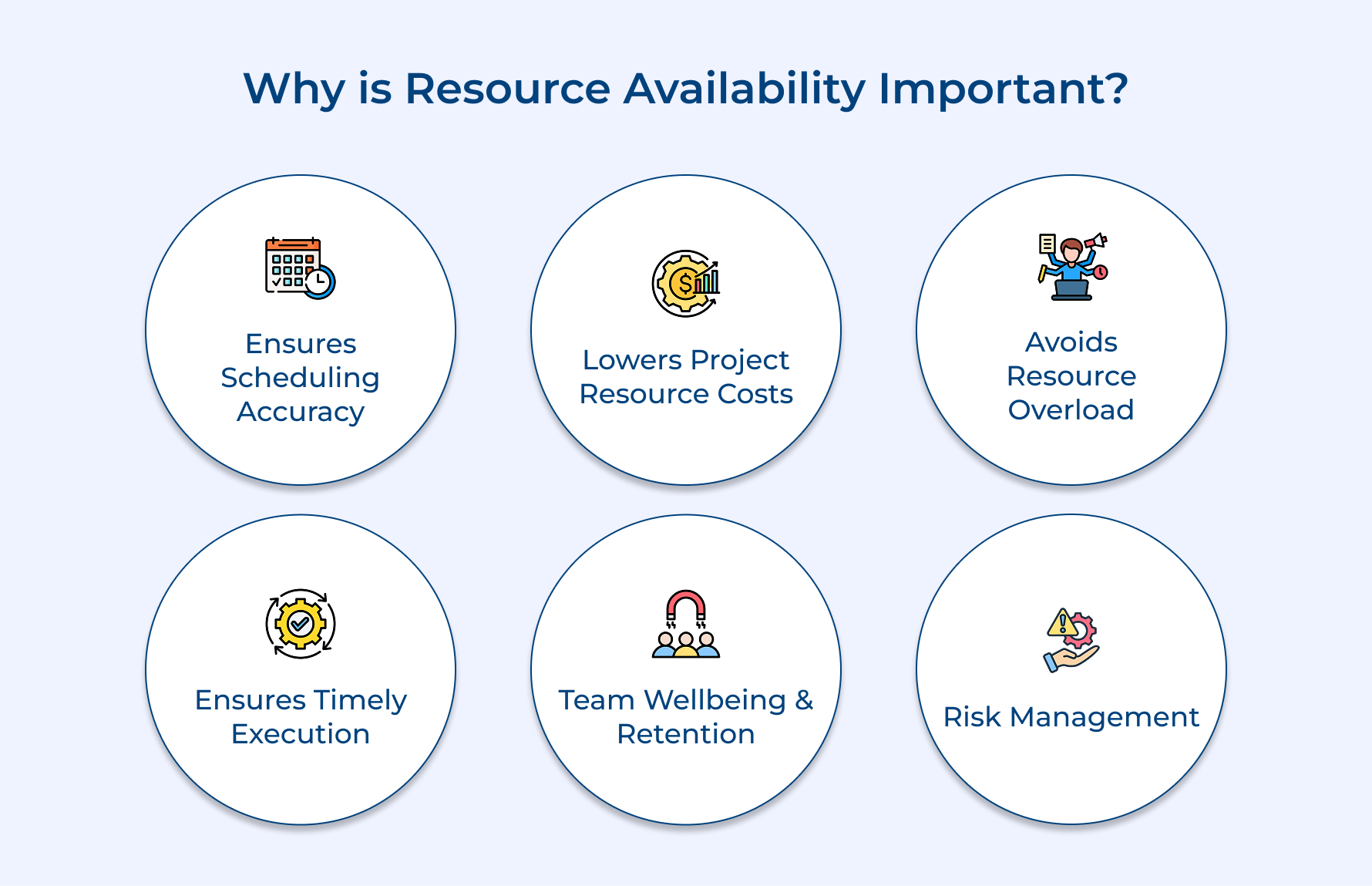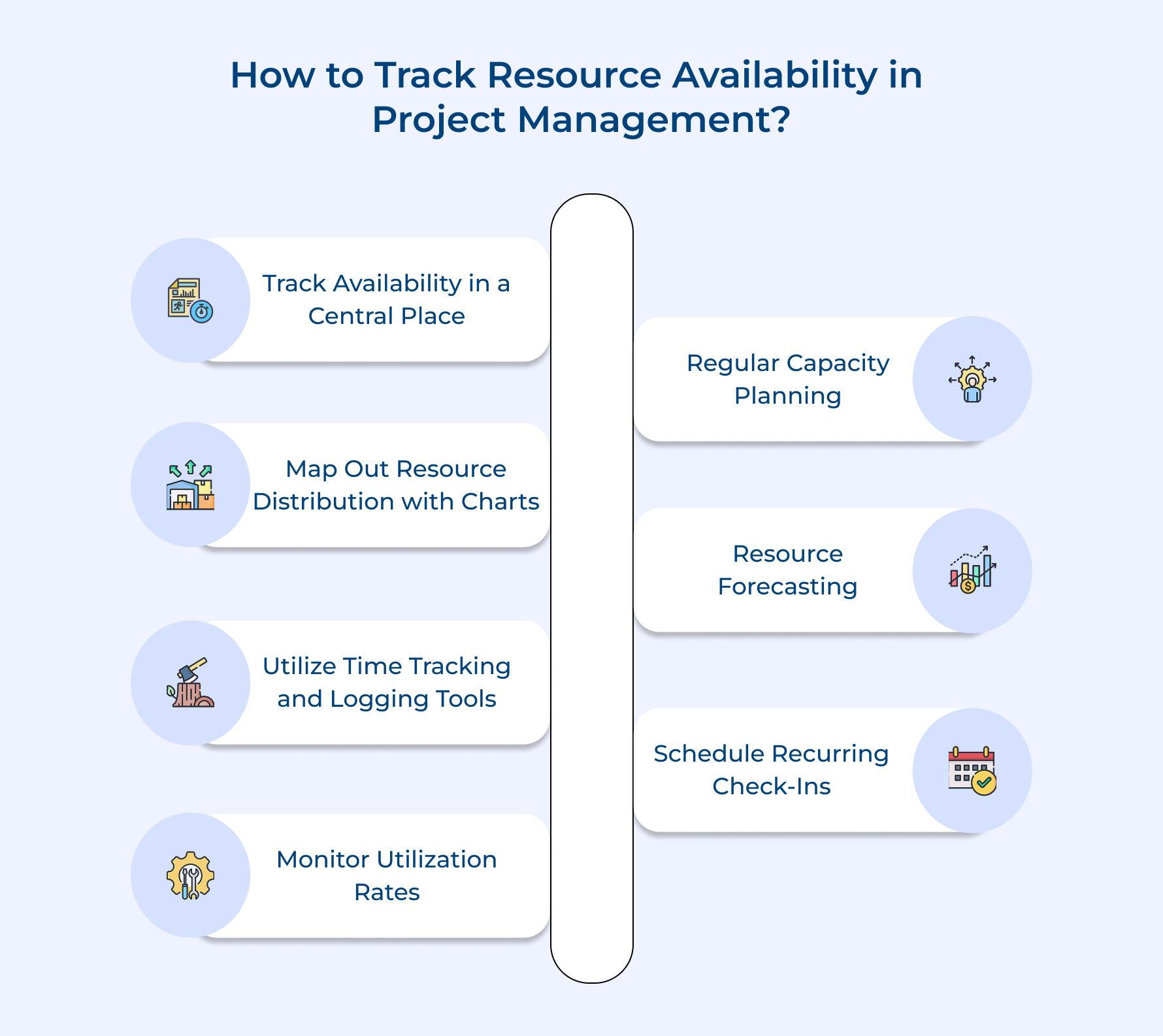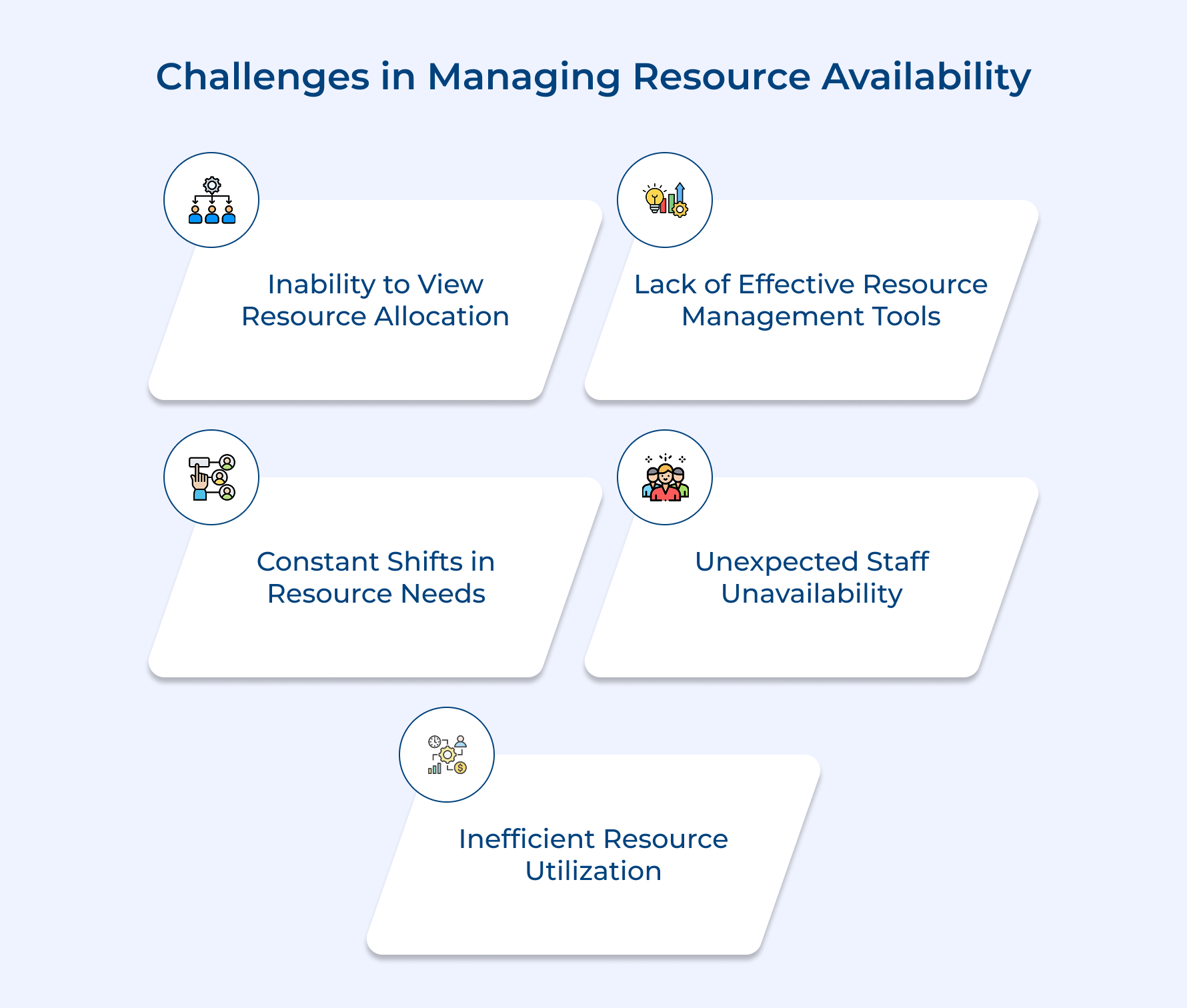How to Track Resource Availability in Project Management?
- What is Resource Availability?
- Why is Resource Availability Important?
- How to Track Resource Availability in Project Management?
- Common Challenges in Managing Resource Availability
- Tips for Resource Availability Management
- Maximizing Productivity with Smart Resource Availability Management
- FAQs about Resource Availability

Key Highlights:
- Effective resource availability management ensures on-time project delivery and prevents overburdened teams.
- Real-time tracking and data analytics optimize resource allocation while also reducing inefficiencies.
- Clear visibility into resource availability helps maximize team efficiency.
Managing resource availability can be a real headache in project management, and it’s one of those things that can either make or break your project’s success.
Don’t worry, with the right strategies and tools, these challenges are manageable. Tracking and forecasting your resource needs helps you ensure that the right people as well as tools are in place exactly when you need them.
Let’s dive into some effective ways to track and optimize resource availability, so you can keep your projects moving forward, meet deadlines, while delivering results without the stress!
What is Resource Availability?
Resource availability in professional services and agencies refers to the organization’s capacity to deploy the right talent, with the right skills, at the right time to meet client demands and project requirements. It encompasses the collective assessment of human capital, expertise, time, and tools that can be allocated to deliver services effectively.
Ensuring the availability of resources helps in managing workloads, reducing stress on employees, and maintaining smooth project execution. It also helps agencies stay competitive by improving profitability while ensuring client commitments are met consistently.
Key objectives:
- Maximize utilization of resources: Ensure billable resources are optimally engaged while maintaining healthy utilization rates that maintain quality.
- Enable strategic growth: Support business development by accurately forecasting capacity for new projects and identifying skill gaps that need to be filled.
- Enhance delivery confidence: Provide reliable data for project planning and commitments, ensuring promises to clients can be fulfilled with existing resources.
Balance resource supply-demand: Match available talent with project requirements while maintaining a flexible buffer for unexpected demands or changes in scope.
Why is Resource Availability Important?
Resource availability formula is all about balancing essential resources, managing project budgets, and meeting resource demand. Let’s explore how else this can help you.
Ensures scheduling accuracy
Knowing exactly when resources are available allows managers to create realistic project timelines and commitments. With precise availability insights, it’s easier to schedule work, assign tasks, and set client expectations without risking conflicts or delays.
Lowers project resource costs
Clear visibility into resource availability helps you make the most of your team while cutting unnecessary expenses. Proper allocation ensures no one is overbooked or underutilized, keeping billable hours optimal and avoiding costly last-minute staffing solutions.
Avoids resource overload
Real-time capacity tracking ensures your team isn’t stretched too thin. By monitoring actual workloads, managers can avoid overburdening their team members, maintaining healthy work levels, and consistently delivering high-quality results.
Ensures timely execution
Tracking resource availability means you can deliver projects on schedule with better staff allocation. Staying on top of resource needs prevents bottlenecks and delays, keeping projects moving smoothly.
Boosts team well-being and retention
Balanced workloads mean less stress and burnout. Assigning tasks based on actual availability helps your team feel valued and supported, leading to higher job satisfaction as well as improved retention.
Improves risk management
Resource tracking gives you an early heads-up on potential risks. Spotting capacity issues or skill gaps early lets you take proactive steps to avoid delays or delivery impacts.
How to Track Resource Availability in Project Management?
Tracking resource availability is key to ensuring smooth execution and preventing bottlenecks during the entire project life cycle. Let’s learn how to track them efficiently.
Track Availability in a Central Place
A centralized and well-maintained system makes tracking resource availability simpler while also being more effective.
Use a centralized system
Keep all resource availability details—like schedules, skills, capacity, and allocations—in one place. This system becomes your single source of truth for managing resources.
- Eliminates confusion: Say goodbye to scattered tools and spreadsheets! A centralized system prevents double-booking and ensures everyone has access to the most current data.
- Improves decision-making: Managers can quickly check availability and plan assignments effectively, keeping the workflow efficient.
Choose the right tools
You can opt for resource management software or a well-structured spreadsheet with clear access protocols.
- Daily updates: Project managers should review and update the system regularly, marking any changes in availability, skills, or project assignments.
- Conduct regular audits: Periodic checks ensure data accuracy and help maintain reliability.
Actionable Tips:
- Implement a standard format for recording availability information, including clear status indicators and essential details about skills as well as capacity.
- Establish clear roles and responsibilities for who can update the central system while also creating a verification process for changes.
- Create automated notifications for key stakeholders when significant availability changes occur or conflicts arise.
Map Out Resource Distribution with Charts
Sharing these visuals in team meetings is a great way to discuss workload balance and adjust plans together.
Use visual charts to simplify resource tracking
Visual tools like Gantt charts, heat maps, or workload charts are perfect for making resource distribution clear and easy to understand.
- Spot issues at a glance: Imagine a heat map showing your team’s workload. You notice one team member is overwhelmed with 120% allocation, while another is at just 50%. This makes it simple to identify and fix imbalances.
- Improve communication: Charts make it easier to explain resource plans to both your team and stakeholders. Instead of long explanations, you can point to a chart and show exactly where the bottlenecks or gaps are.
Create and maintain dynamic charts
Design color-coded charts to show allocation percentages. For instance, use green for balanced workloads, red for overallocation, and blue for availability.
- Update regularly: Refresh your charts weekly to reflect any changes in assignments or availability.
- Use filters: Want to see resource distribution by skill set or project phase? Apply filters to get a clear view of exactly what you need.
Actionable Tips:
- Choose visualization types based on your audience – Gantt charts for timeline focus, heat maps for workload intensity, and capacity charts for availability.
- Set up automatic data synchronization between your tracking system and visualization tools to maintain real-time accuracy.
- Include critical milestones and dependencies in your charts to show how resource distribution impacts project timelines.
Utilize Time Tracking and Logging Tools
Time-tracking tools are a game-changer for understanding how resources are utilized. Record the time spent on tasks and projects, you gain real data about utilization patterns as well as availability. It helps identify productivity trends, uncover hidden time sinks, and refine future planning using historical insights.
The key is to use user-friendly time-tracking software integrated with your project management tools. Encourage your team to log time daily or weekly using specific project codes. Then, review the reports monthly to spot trends and make necessary adjustments for better resource management.
Actionable Tips:
- Make time tracking simple and accessible with mobile apps as well as browser extensions for easy logging.
- Create clear categories and codes for different types of work to ensure meaningful data collection.
- Review time tracking data monthly to identify patterns and adjust resource availability calculations accordingly.
Monitor Utilization Rates
Keeping an eye on how effectively resources are used is essential for profitability and team efficiency. Tracking utilization rates like comparing billable hours to total available hours, you get to measure productivity across projects and activities.
This way, you maintain balanced workloads, spot capacity issues, and allocate resources efficiently to maximize billable hours without overburdening your team.
To stay on top of this, calculate weekly utilization rates for individuals as well as teams. Set realistic target ranges, track trends, and use the data to adjust allocations or bring in extra help when needed.
Actionable Tips:
- Set realistic utilization targets based on role types and account for non-billable but necessary activities.
- Create dashboards showing real-time utilization rates compared to targets and historical trends.
- Implement regular reviews of utilization data with team leads to address imbalances proactively.
Regular Capacity Planning
The systematic process of assessing as well as planning resource capacity against current and upcoming project demands, ensuring adequate resources are available for all commitments.
Regular capacity planning offers,
- Prevents resource shortages
- Helps maintain balanced workloads
- Enables strategic decisions about taking on new projects.
- Ensures the organization can meet commitments while maintaining quality and team well-being.
What can you do next?
Conduct monthly capacity planning sessions reviewing upcoming projects against available resources. Use data to make decisions about hiring, training, or project scheduling adjustments.
Actionable Tips:
- Schedule monthly capacity planning meetings with key stakeholders to review upcoming needs and current availability.
- Maintain a rolling three-month view of capacity requirements and update it weekly with new information.
- Create contingency plans for high-demand periods identified through capacity planning.
Resource Forecasting
Predictive analysis of future resource needs based on historical data, upcoming projects, and business trends to anticipate as well as plan for future resource requirements.
Forecasting helps organizations,
- Prepare for future demands by identifying potential resource gaps or surpluses early.
- Enables proactive hiring, training, and resource development to meet future project needs effectively.
Analyze historical project data and upcoming opportunities to project future resource needs. Use forecasting tools to model different scenarios and plan accordingly for various business outcomes.
Actionable Tips:
- Develop multiple forecast scenarios (conservative, moderate, aggressive) to prepare for different business situations.
- Include skill development and training time in forecasts to ensure resources are prepared for future needs.
- Review and adjust forecasts quarterly based on actual performance as well as changing business conditions.
Schedule Recurring Check-Ins
Regular meetings and reviews are essential for staying proactive about resource availability, workload balance, as well as capacity challenges.
Hold regular meetings
Schedule regular check-ins with team members and project managers to discuss resource availability, workloads, along with capacity issues in real time.
- Spot issues early: These reviews help identify potential conflicts or bottlenecks before they escalate.
- Encourage open communication: Team members can share workload concerns, ensuring managers can address them promptly.
Set a routine
Plan weekly team availability reviews to discuss overall resource needs and monthly one-on-one check-ins for deeper insights.
- Use structured agendas: Cover current workloads, upcoming requirements, and any challenges affecting availability.
Actionable Tips:
- Create standardized check-in templates covering key availability and capacity discussion points.
- Schedule check-ins at consistent times that don’t interfere with peak productive hours.
- Document outcomes and action items from each check-in to ensure follow-through on identified needs.
Common Challenges in Managing Resource Availability
Managing resources can be tricky, with several challenges that can derail a project’s progress. Here’s the list of common challenges in resource availability and solutions on how to tackle them.
Inability to View Resource Allocation in Real-time
It’s tough to manage resources without a clear view of current commitments or availability, often leading to double bookings, missed deadlines, and overworked teams.
Solution: Implement centralized resource management platforms with real-time dashboards and automated updates. This gives teams a clear picture of resource schedules.
Pro tip: Establish clear protocols for updating availability and share standardized reports with all stakeholders. Regular training ensures everyone can use the system effectively.
Lack of Effective Resource Management Tools
Relying on outdated spreadsheets or disconnected tools can make managing both financial and physical resources a challenge.
Solution: Invest in integrated resource management software that streamlines scheduling, time tracking, and capacity planning. Choose a tool that fits your workflow and integrates with project management systems.
Pro tip: Prioritize tools that offer customizable reports and automated conflict alerts to simplify decision-making while also improving resource allocation.
Constant Shifts in Resource Needs Across Projects
Changing project scopes, shifting client demands, and evolving priorities can disrupt resource plans, especially when dealing with scarce resources.
Solution: Build flexibility into resource allocation by keeping a buffer of unallocated time for high-priority changes. Use a change management process to evaluate the impact of shifts before moving forward.
Pro tip: Hold regular scenario planning sessions to prepare for resource shifts and develop quick response strategies.
Unexpected Staff Unavailability and Workforce Turnover
Sudden absences or resignations can disrupt resource schedules and overload the remaining staff.
Solution: Develop cross-training programs so that team members can step in when needed. Keep an updated skills matrix and build relationships with freelancers to quickly fill gaps.
Pro tip: Maintain a talent pipeline to ensure access to additional resources when turnover hits.
Inefficient Resource Utilization
When resources aren’t allocated properly or priorities aren’t clear, it leads to wasted potential and frustration.
Solution: Regularly monitor resource utilization and set targets for billable versus non-billable time. Balance workloads and ensure assignments match skill levels.
Pro tip: Review utilization data to spot patterns and improve efficiency, while skill development programs ensure your team remains engaged as well as capable.
Tips for Resource Availability Management
Effective resource management is key to keeping projects on track and avoiding delays. Here are some strategies for resource availability to help ensure your team has the right things at the right time.
Utilize Resource Pooling Across Projects
Resource pooling involves sharing resources across multiple projects, ensuring that they are used efficiently and are not allocated exclusively to one task. Here, you can allocate the right skills and expertise where they are most needed, ensuring projects are completed on time without resource conflicts.
Implement Agile Resource Management Practices
Adopting agile resource management practices allows for flexibility and responsiveness in managing resources. By breaking projects into smaller tasks and continuously reassessing resource needs, teams can quickly adapt to changing requirements or unexpected challenges. Thus, ensuring resources are allocated dynamically and efficiently.
Set Clear Utilization Targets
Establish realistic utilization targets for different roles and resource types. Consider optimal billable hours, accounting for administrative tasks, training time, and buffer for unexpected work. Monitor these targets regularly.
Monitor Project Pipeline
Keep a rolling forecast of upcoming projects and their resource requirements. Review the pipeline regularly to identify potential capacity issues early. Adjust resource acquisition or project timing based on availability.
Leverage Data and Analytics for Better Decisions
Use data analytics tools to assess past resource performance, project completion rates, and utilization trends. Analyzing historical data allows you to make more informed decisions about resource allocation, better forecast future needs, and identify patterns that can improve your resource management strategy.
Maximizing Productivity with Smart Resource Availability Management
Effective management of resource availability is crucial for project success. Ensuring resources are allocated properly at the right time helps prevent bottlenecks, delays, and inefficiencies. Proper planning and foresight allow project managers to optimize resources as well as keep projects on schedule.
Real-time tracking and accurate forecasting play a pivotal role in maintaining smooth resource availability. Regular assessments help identify resource gaps and make adjustments to avoid disruptions.
Implementing best practices in resource management keeps teams productive, workflows streamlined, and projects delivered successfully while also being on time.
Limit time — not creativity
Everything you need for customer support, marketing & sales.
Neeti Singh is a passionate content writer at Kooper, where he transforms complex concepts into clear, engaging and actionable content. With a keen eye for detail and a love for technology, Tushar Joshi crafts blog posts, guides and articles that help readers navigate the fast-evolving world of software solutions.



